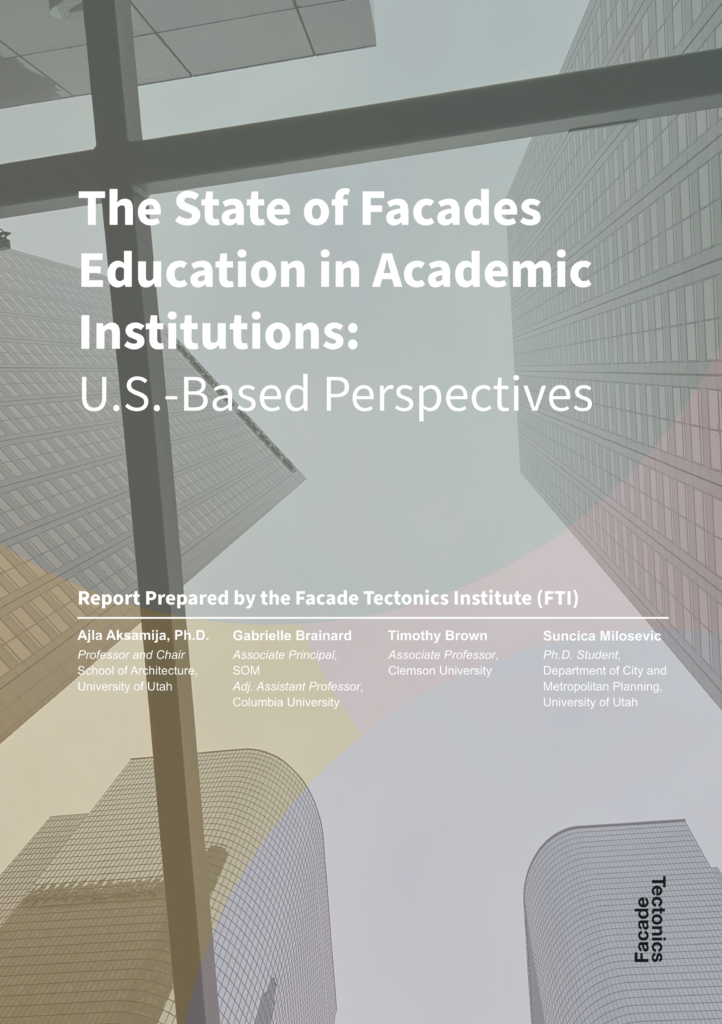
“The State of Facades Education in Academic Institutions: U.S.-Based Perspectives” outlines the results of a research study investigating the state of facades education at higher-education institutions across the United States. The objective was to identify courses focusing on facades, and analyze how these courses relate to the overall curricula, educational content, and teaching methods at various universities. The study began by identifying universities that offer facade-related courses, and by administering a survey via the Facade Tectonics Institute's membership, the Society of Building Science Educators, and the Building Technology Educators’ Society. The survey asked participants to identify facades-related courses in their institutions, provide the course names and numbers, indicate course level (graduate or undergraduate), course format (studio, lecture, seminar) and the relation to the curriculum (elective or required course). Contact information for instructors was collected as well. Subsequently, syllabi were requested from instructors for each of the identified courses. Around seventy facade-related courses were identified in various North American programs. However, detailed information and course syllabi were collected for thirty-six facade-related courses offered by the U.S. higher-education institutions.
The next step of the research study involved quantitative and qualitative analysis of the submitted syllabi. The collected information was classified into different categories, including geographic regions, program type, course format, whether the courses are offered as part of a professional program, instructor type, identification of topics that are covered in various classes, learning outcomes, and course assessment methods. The results indicate that the majority of the U.S. facade-related courses are offered in the East region, followed by the Midwest, West and Southeast region. Also, the majority of the courses are offered at institutions located in major metropolitan areas, and a slightly higher number of courses are offered by private institutions compared to public universities. Courses are predominantly graduate-level and elective courses, indicating that the pool of students who gain exposure and knowledge of facades and facade systems in the U.S. is significantly smaller than anticipated and alarmingly small given the importance of this subject matter. The findings also indicate that U.S. architecture programs typically intertwine facade-related educational content into building technology lecture courses and integrated or comprehensive architecture design studios. In order to improve the state of facade education in the U.S., it is necessary to expand course offerings that offer in-depth study of facade systems, design processes, physical behavior, structural analysis, technical detailing, materials, building performance analysis, etc. Courses that introduce emerging materials and facade technologies, new fabrication methods, as well as rapidly evolving construction techniques would greatly benefit the architectural/engineering/construction industry.
The recommendation for architectural programs is to carefully consider, especially in light of changing National Architectural Accrediting Board (NAAB) accreditation requirements, how technical topics are to be more fully integrated into curricula. For undergraduate pre-professional programs, introduction to basic principles of facade design is beneficial since this allows students to understand relationships between architectural design and building aesthetics, materials and assemblies, and to develop an understanding of the relationships between enclosure design and building performance. For NAAB accredited professional programs, deeper understanding about facades’ design and performance, impact on building systems, integration with structure and HVAC/lighting systems, technical detailing, and emerging technologies is critical to prepare students for professional careers. Developing more specialized graduate programs, such as graduate certificate programs, Master of Science and Doctoral programs that focus on facades is necessary in order to expand research and development efforts, as well as the collective “state-of-knowledge” relating to facade systems.
Citation:
Aksamija, A., Brainard, G., Brown, T., and Milosevic, S., (2023). “The State of Facades Education in Academic Institutions: U.S.-Based Perspectives”, Facade Tectonics Institute.
